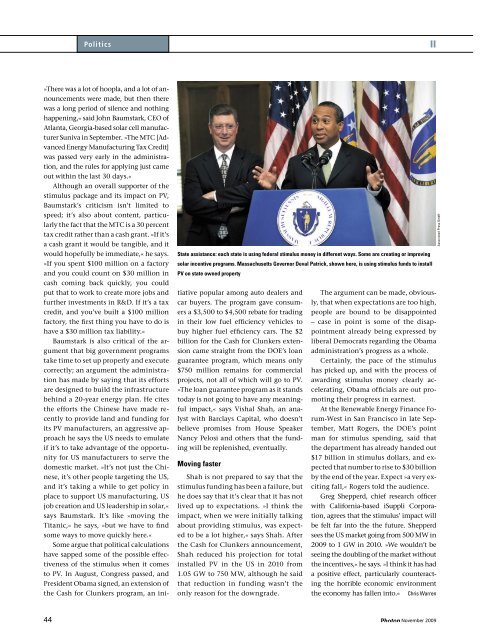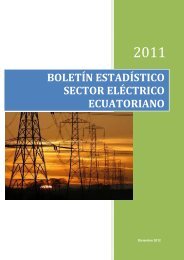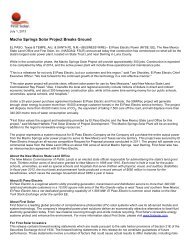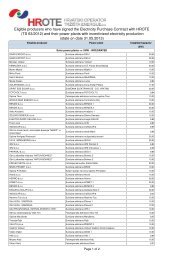INTRODUCTORY SPECIAL INTRODUCTORY ... - PHOTON Info
INTRODUCTORY SPECIAL INTRODUCTORY ... - PHOTON Info
INTRODUCTORY SPECIAL INTRODUCTORY ... - PHOTON Info
Create successful ePaper yourself
Turn your PDF publications into a flip-book with our unique Google optimized e-Paper software.
Politics<br />
»There was a lot of hoopla, and a lot of an-<br />
nouncements were made, but then there<br />
was a long period of silence and nothing<br />
happening,« said John Baumstark, CEO of<br />
Atlanta, Georgia-based solar cell manufac-<br />
turer Suniva in September. »The MTC [Ad-<br />
vanced Energy Manufacturing Tax Credit]<br />
was passed very early in the administra-<br />
tion, and the rules for applying just came<br />
out within the last 30 days.«<br />
44<br />
Although an overall supporter of the<br />
stimulus package and its impact on PV,<br />
Baumstark’s criticism isn’t limited to<br />
speed; it’s also about content, particu-<br />
larly the fact that the MTC is a 30 percent<br />
tax credit rather than a cash grant. »If it’s<br />
a cash grant it would be tangible, and it<br />
would hopefully be immediate,« he says.<br />
»If you spent $100 million on a factory<br />
and you could count on $30 million in<br />
cash coming back quickly, you could<br />
put that to work to create more jobs and<br />
further investments in R&D. If it’s a tax<br />
credit, and you’ve built a $100 million<br />
factory, the first thing you have to do is<br />
have a $30 million tax liability.«<br />
Baumstark is also critical of the ar-<br />
gument that big government programs<br />
take time to set up properly and execute<br />
correctly; an argument the administra-<br />
tion has made by saying that its efforts<br />
are designed to build the infrastructure<br />
behind a 20-year energy plan. He cites<br />
the efforts the Chinese have made re-<br />
cently to provide land and funding for<br />
its PV manufacturers, an aggressive ap-<br />
proach he says the US needs to emulate<br />
if it’s to take advantage of the opportu-<br />
nity for US manufacturers to serve the<br />
domestic market. »It’s not just the Chi-<br />
nese, it’s other people targeting the US,<br />
and it’s taking a while to get policy in<br />
place to support US manufacturing, US<br />
job creation and US leadership in solar,«<br />
says Baumstark. It’s like »moving the<br />
Titanic,« he says, »but we have to find<br />
some ways to move quickly here.«<br />
Some argue that political calculations<br />
have sapped some of the possible effec-<br />
tiveness of the stimulus when it comes<br />
to PV. In August, Congress passed, and<br />
President Obama signed, an extension of<br />
the Cash for Clunkers program, an ini-<br />
State assistance: each state is using federal stimulus money in different ways. Some are creating or improving<br />
solar incentive programs. Massachusetts Governor Deval Patrick, shown here, is using stimulus funds to install<br />
PV on state owned property<br />
tiative popular among auto dealers and<br />
car buyers. The program gave consum-<br />
ers a $3,500 to $4,500 rebate for trading<br />
in their low fuel efficiency vehicles to<br />
buy higher fuel efficiency cars. The $2<br />
billion for the Cash for Clunkers exten-<br />
sion came straight from the DOE’s loan<br />
guarantee program, which means only<br />
$750 million remains for commercial<br />
projects, not all of which will go to PV.<br />
»The loan guarantee program as it stands<br />
today is not going to have any meaning-<br />
ful impact,« says Vishal Shah, an ana-<br />
lyst with Barclays Capital, who doesn’t<br />
believe promises from House Speaker<br />
Nancy Pelosi and others that the fund-<br />
ing will be replenished, eventually.<br />
Moving faster<br />
Shah is not prepared to say that the<br />
stimulus funding has been a failure, but<br />
he does say that it’s clear that it has not<br />
lived up to expectations. »I think the<br />
impact, when we were initially talking<br />
about providing stimulus, was expect-<br />
ed to be a lot higher,« says Shah. After<br />
the Cash for Clunkers announcement,<br />
Shah reduced his projection for total<br />
installed PV in the US in 2010 from<br />
1.05 GW to 750 MW, although he said<br />
that reduction in funding wasn’t the<br />
only reason for the downgrade.<br />
ıı<br />
The argument can be made, obvious-<br />
ly, that when expectations are too high,<br />
people are bound to be disappointed<br />
– case in point is some of the disap-<br />
pointment already being expressed by<br />
liberal Democrats regarding the Obama<br />
administration’s progress as a whole.<br />
Certainly, the pace of the stimulus<br />
has picked up, and with the process of<br />
awarding stimulus money clearly ac-<br />
celerating, Obama officials are out pro-<br />
moting their progress in earnest.<br />
At the Renewable Energy Finance Fo-<br />
rum-West in San Francisco in late Sep-<br />
tember, Matt Rogers, the DOE’s point<br />
man for stimulus spending, said that<br />
the department has already handed out<br />
$17 billion in stimulus dollars, and ex-<br />
pected that number to rise to $30 billion<br />
by the end of the year. Expect »a very ex-<br />
citing fall,« Rogers told the audience.<br />
Greg Shepperd, chief research officer<br />
with California-based iSuppli Corpora-<br />
tion, agrees that the stimulus’ impact will<br />
be felt far into the the future. Shepperd<br />
sees the US market going from 500 MW in<br />
2009 to 1 GW in 2010. »We wouldn’t be<br />
seeing the doubling of the market without<br />
the incentives,« he says. »I think it has had<br />
a positive effect, particularly counteract-<br />
ing the horrible economic environment<br />
the economy has fallen into.« Chris Warren<br />
November 2009<br />
Associated Press GmbH

















